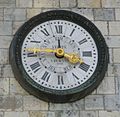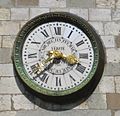Besançon Astronomical Clock
The Besançon Astronomical Clock is located in the tower of the Saint-Jean Cathedral in Besançon in eastern France . It was created from 1858 to 1860 as an astronomical clock by Auguste-Lucien Vérité , who later also made the astronomical clock in the Cathedral of Beauvais . The watch is still operated purely mechanically today and has to be wound up every day.
clockwork
The actual astronomical clock is housed in an ornate neo-renaissance case . The housing is 5.80 m high, 2.50 m wide and 1 m deep. It is in a special clock room on the first floor of the tower vault. What is unusual for astronomical cathedral clocks is that the mechanical clockwork simultaneously takes on the function of the tower clock and from here controls the hammers of the bell in the tower and also the outer dials via wire cables (hammer pulls) and cardan shafts (pointer cables) .
The movement of the Besançon clock is extremely robust and made of a fine cast bronze construction. It has a 30 kg, temperature-compensated nine-rod (rust) seconds pendulum and an auxiliary elevator ( remontoir d'égalité ) . The auxiliary elevator makes it possible to drive the pendulum with an auxiliary weight of only 20 grams, although the clock not only moves 122 astronomical displays on 70 dials, but also the dial in the nave and the four dials of the tower clock. So the clock is both a tower clock and an astronomical clock. Around a hundred meters of cardan shaft gears - experts refer to them as pointer cables - connect the outer dials with the astronomical tower clock in the clock room. In addition to the time, each of the four tower dials shows a special indication (moon age, date, day of the week, month). The dials measure two meters in diameter. The one facing the city is fringed by the two quarter bells and measures three meters in diameter. The outer dials are made in French style from enamel cartridges and framed with a bronze bezel . The dial in the nave also shows the phases of the moon, the days of the week and the planets assigned to the day of the week.
Outside dials
sightseeing
The Besançon clock can be viewed every hour except Tuesdays and Wednesdays. The impressive clockwork with the play of figures, the apostle's run, the resurrection of Christ etc. can be viewed from close up in full function.
literature
- The Astronomical Clock of Besançon - German edition, P. Brandibas-Goudey, 1941. 15 pages.
Web links
- Center des monuments nationaux: Cathédrale de Besançon et son horloge astronomique (French)
- M. Hanke: Astronomical Clock of Besancon (English)






